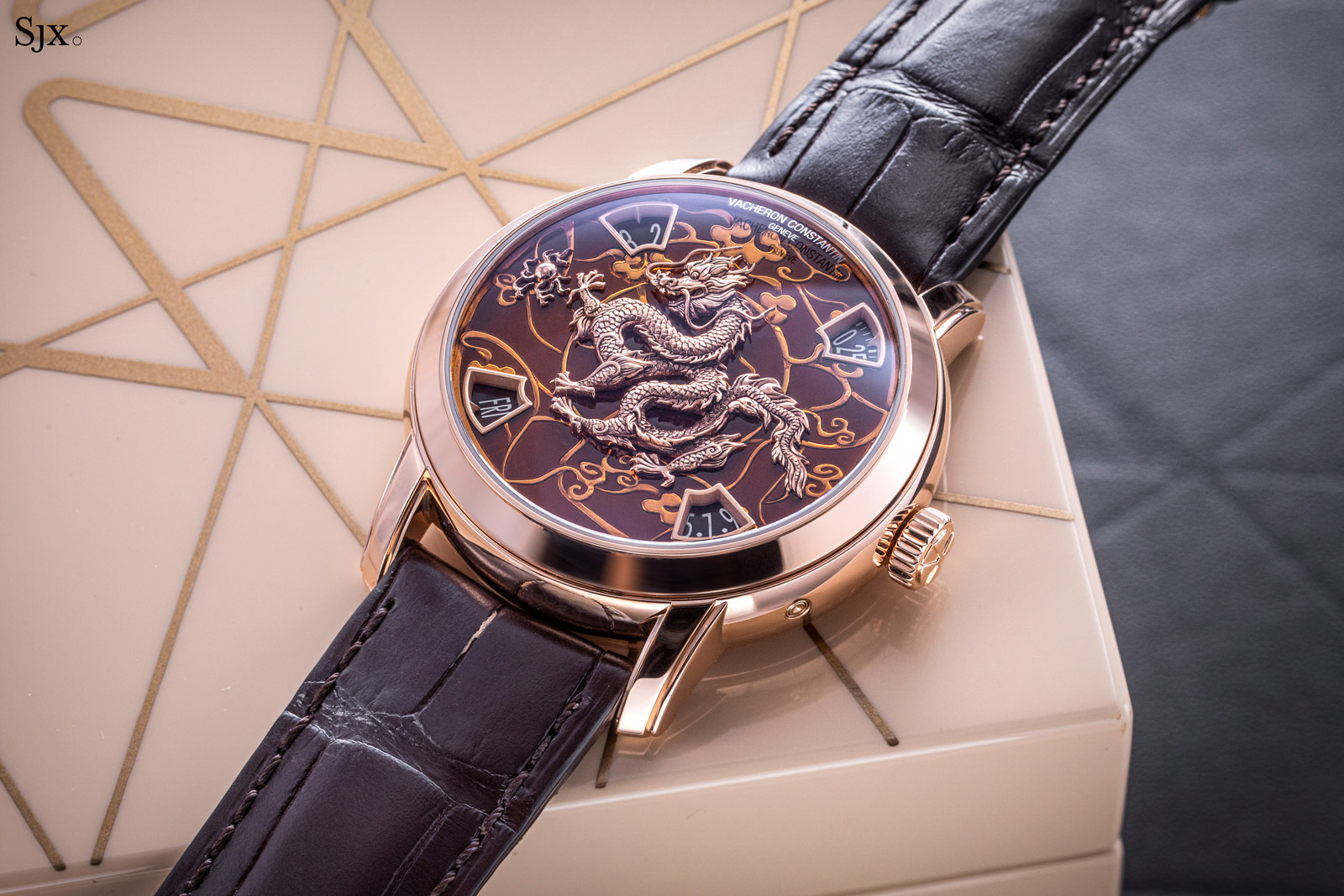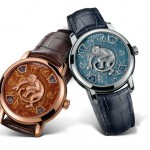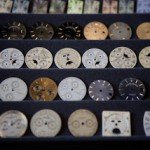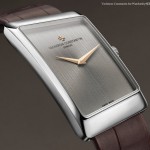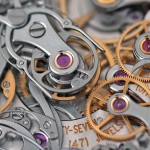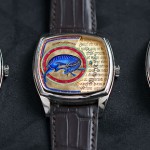Review: Vacheron Constantin Métiers d’Art Chinese Zodiac “Year of the Dragon”
Artisanal, auspicious, and cleverly presented.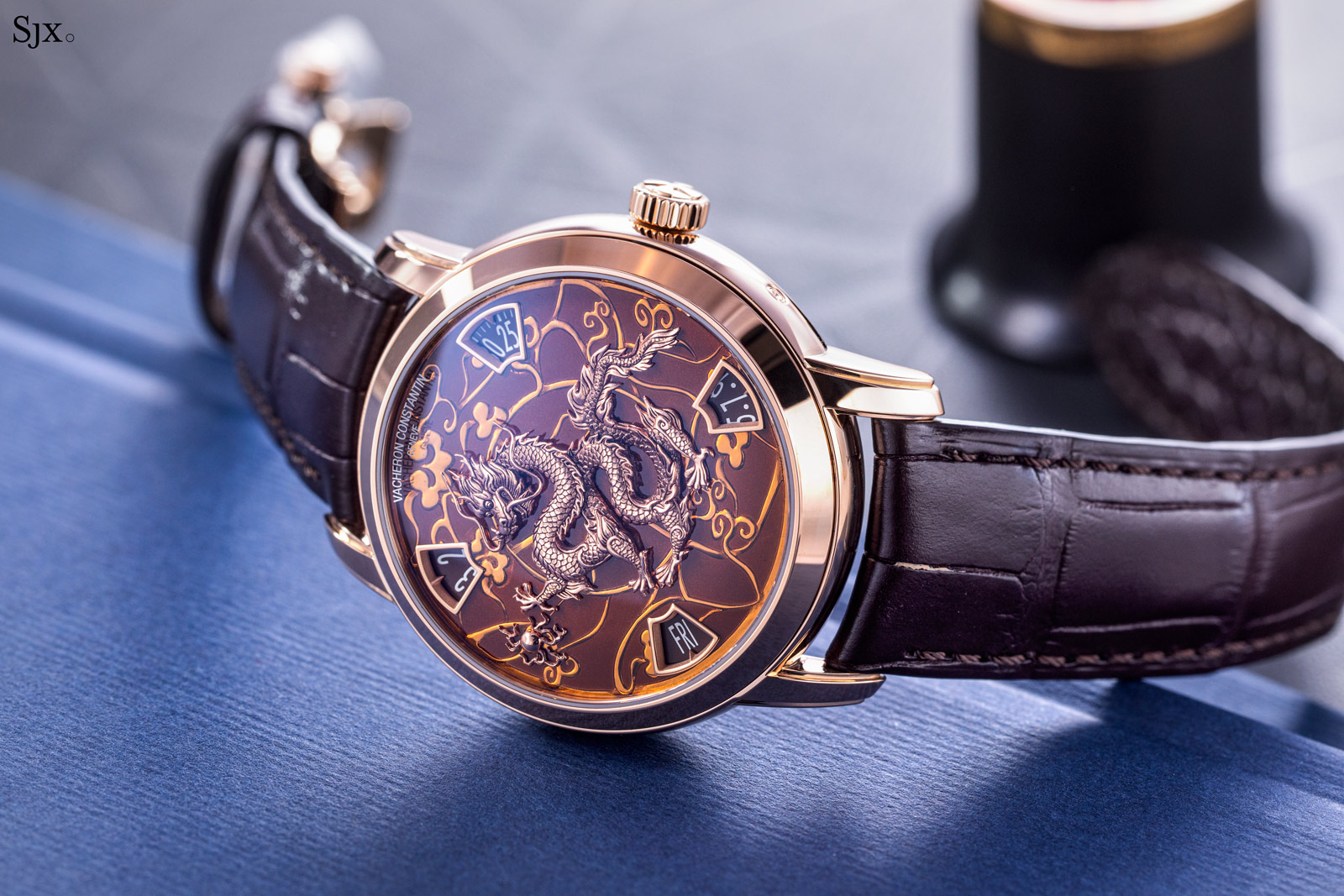
Arriving just as the Dragon year begins in February, the Vacheron Constantin Métiers d’Art The Legend of the Chinese Zodiac “Year of the Dragon” is the latest illustration of the Geneva brand’s artisanal and technical capabilities, with a hand-engraved dragon sculpture on a grand feu enamel dial and an in-house calibre that indicates the time and calendar on discs.
The “Year of the Dragon” is the final chapter in the brand’s Chinese Zodiac collection, an annual series of limited editions that began in 2012 with the rabbit. With the Chinese zodiac made up of a repeating 12-year cycle – with each year represented by an animal – the series reaches its conclusion with this dragon edition, which like its predecessors is available in either pink gold or platinum.
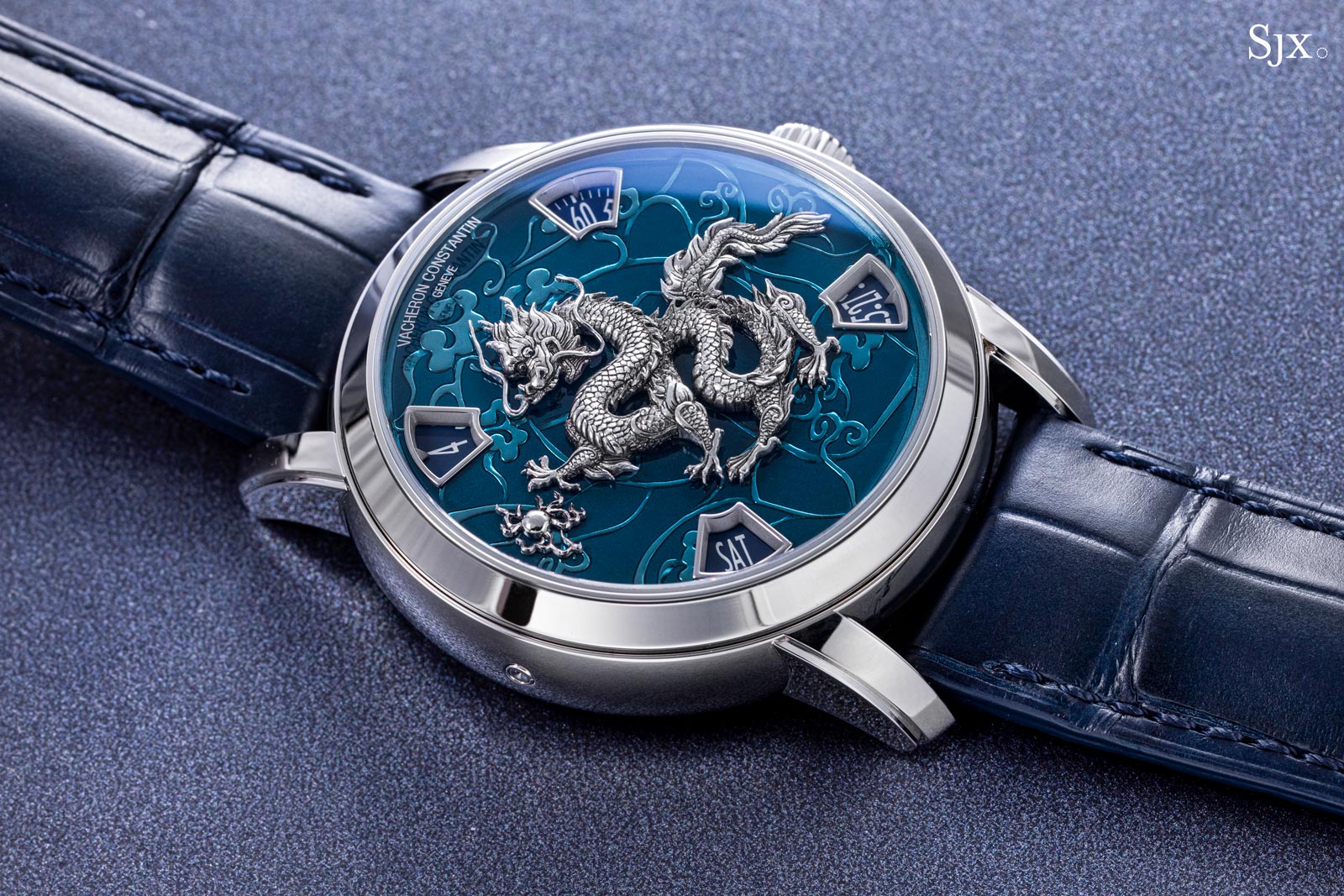
Initial thoughts
Dragon-themed watches have already started to proliferate with the incoming Year of the Dragon, simply because the dragon has the most universal appeal amongst all of the zodiac animals. It carries desirable symbolism across East Asia, as opposed to say, the rodent or pig, which have a niche audience. So the appeal of a dragon watch is arguably less about the motif, which is now common, but the execution. And here the Metiers d’Art “Year of the Dragon” excels in both presentation and technique.
I’ve always been fond of Vacheron Constantin’s quadruple-disc display because it is both logical and attractive. The display makes sense because it leaves majority of the dial free for decoration, yet it manages to show both the time and calendar. At the same time, the windows give the dial symmetry and serve as a frame for the decoration in the centre. The display is straightforward yet novel, and possesses both aesthetic and technical appeal.
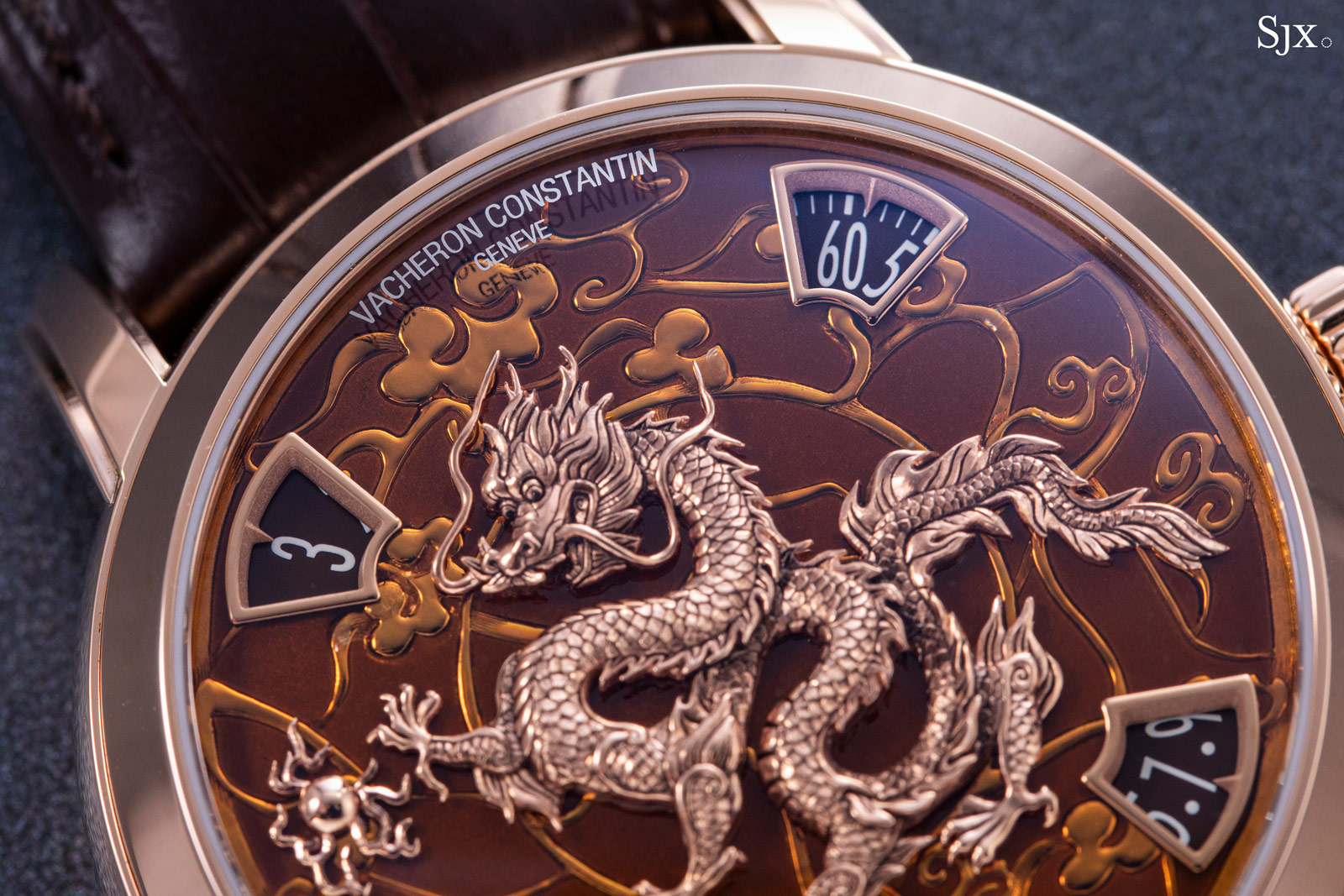
Metiers d’art watches, regardless of brand, typically add decoration to existing models, whereas here the calibre was conceived specifically to cater to decorated dials, making it unique to Vacheron Constantin (VC). Although the brand’s Metiers d’Art watches go from wandering hours to the famous double-retrograde of the Mercator, the four-window dial is arguably the quintessential look of its Metiers d’Art collection.
The “Year of the Dragon” combines the familiar display with a finely executed dial that combines both engraving and enamelling. The dragon is rendered in great detail in the traditional Chinese manner, chasing a flaming pearl across the clouds.
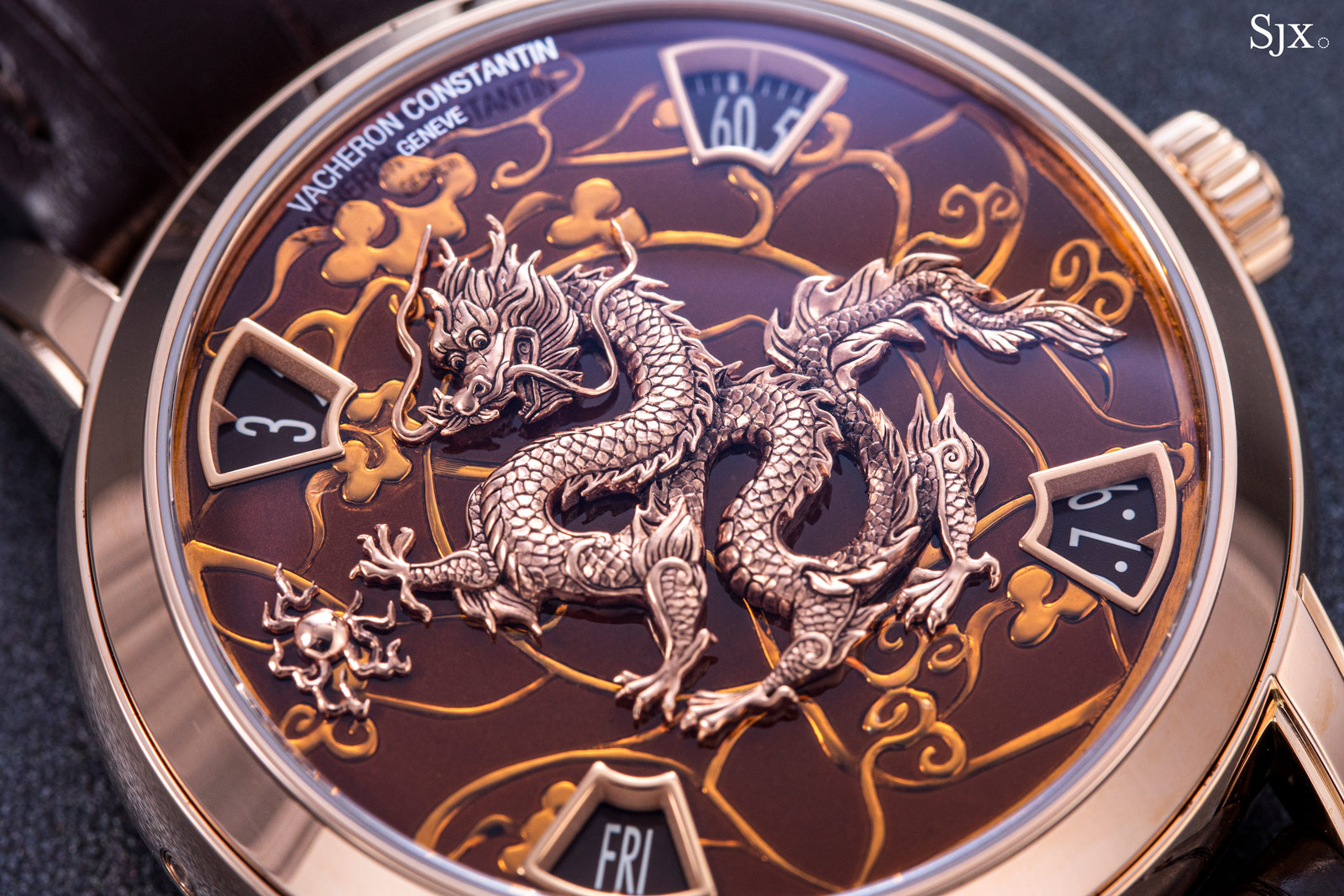
Between the platinum and pink gold models, I would choose the latter because its colours are richer. At the same time, the brown enamel dial is arguably more suited to the dragon motif, since it is a more traditional shade.
Paradoxically, if I could change one aspect of the watch, it would be dial colour. The entire zodiac series is presented in the same colour pairing – blue and platinum, brown and pink gold – so it doesn’t have much aesthetic variance. The desire for uniformity is understandable since the collection was conceived as a continuous series over 12 years. That said, I would have liked different colours for each zodiac animal, perhaps reflecting the nature of the animal, orange for the tiger and yellow for the dragon, for example. And for the rare few who religiously collect the entire set, having some visual diversity would certainly make it more interesting.
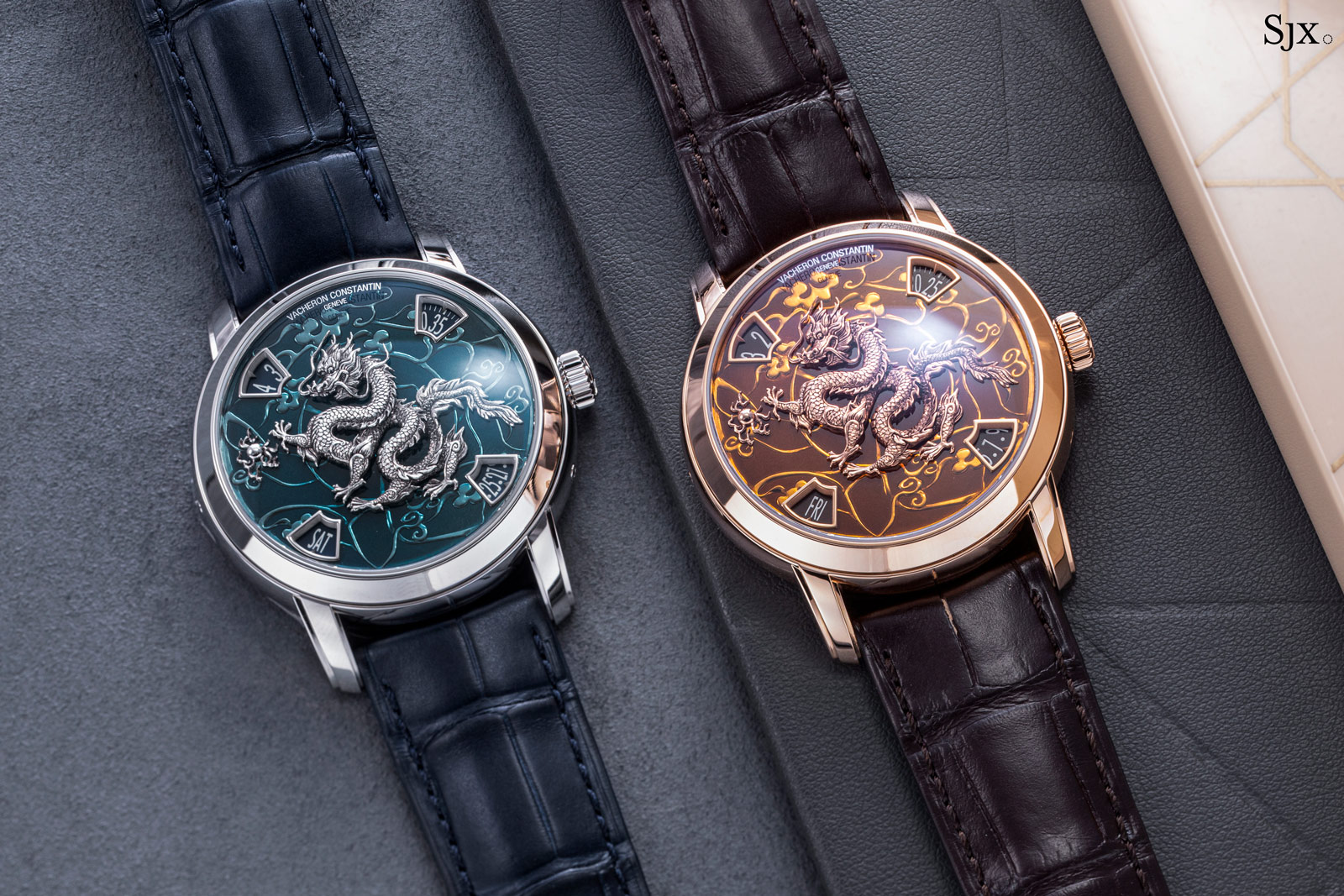
Platinum (left), and pink gold
And I wish the case was a bit thinner. The case is simple in form, but distinctive thanks to the fluting along the edges of the lugs. At 12.72 mm high, however, it is tall for a classical watch. The case thickness is justified by the enamel dial and sculpture, as well as the disc-based display, all elements that add substantially to the height.
More broadly, the “Year of the Dragon” is appealing because it’s relatable, at least for me as a collector of Chinese descent. VC’s métiers d’art repertoire is diverse, with inspiration ranging from the ancient world to 16th century Japanese lacquered folding screens. Most of these are exquisitely executed, but some are centred on esoteric themes.
The “Year of the Dragon” is priced at US$112,000 in gold (and more in platinum), which is a hefty sum but a reasonable proposition relative to the rest of the market, which admittedly has grown a lot more expensive in recent years. Take as a comparison the Jaeger-LeCoultre Reverso “Dragon” introduced for the same occasion. Despite a simpler movement, less complex enamelling and engraving, and a different level of brand prestige, the Reverso retails for US$107,000.
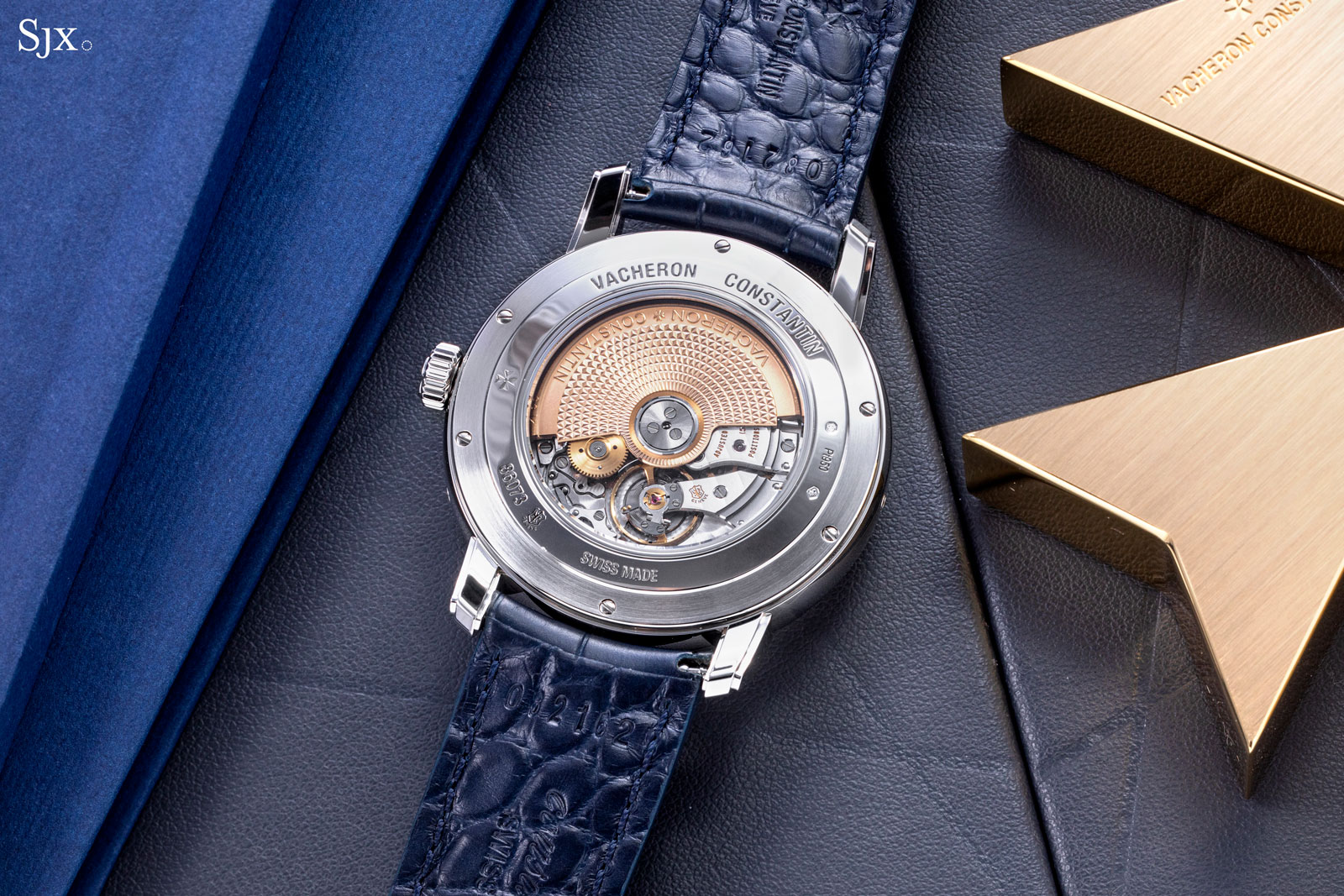
The cal. 2460 G4
A blank canvas
With all of the indications on the periphery, the dial is an ideal platform for decoration, particularly something substantial that would not fit on a conventional dial with hands in the centre. VC has used this to good effect in the past, installing micro-sculptures of all stripes on the dial, ranging from tribal masks to zodiac animals.
The “Year of the Dragon” has a Chinese dragon at its centre on an enamel dial bearing a cloud motif. Both the dragon and dial base are solid gold, decorated by hand to an impressively high standard. Engraving and enamelling are both done in-house, reflecting VC’s steady expansion of its artisanal crafts workshop over the years, and also explaining the consistent diversity of its elaborately decorated Les Cabinotiers offerings.
The dragon begins as a blank with the silhouette of a dragon but none of the detail. All of the intricate elements that make up the dragon, from the eyes to the scales to the beard, are engraved by hand, a process that requires three day’s work according to VC.
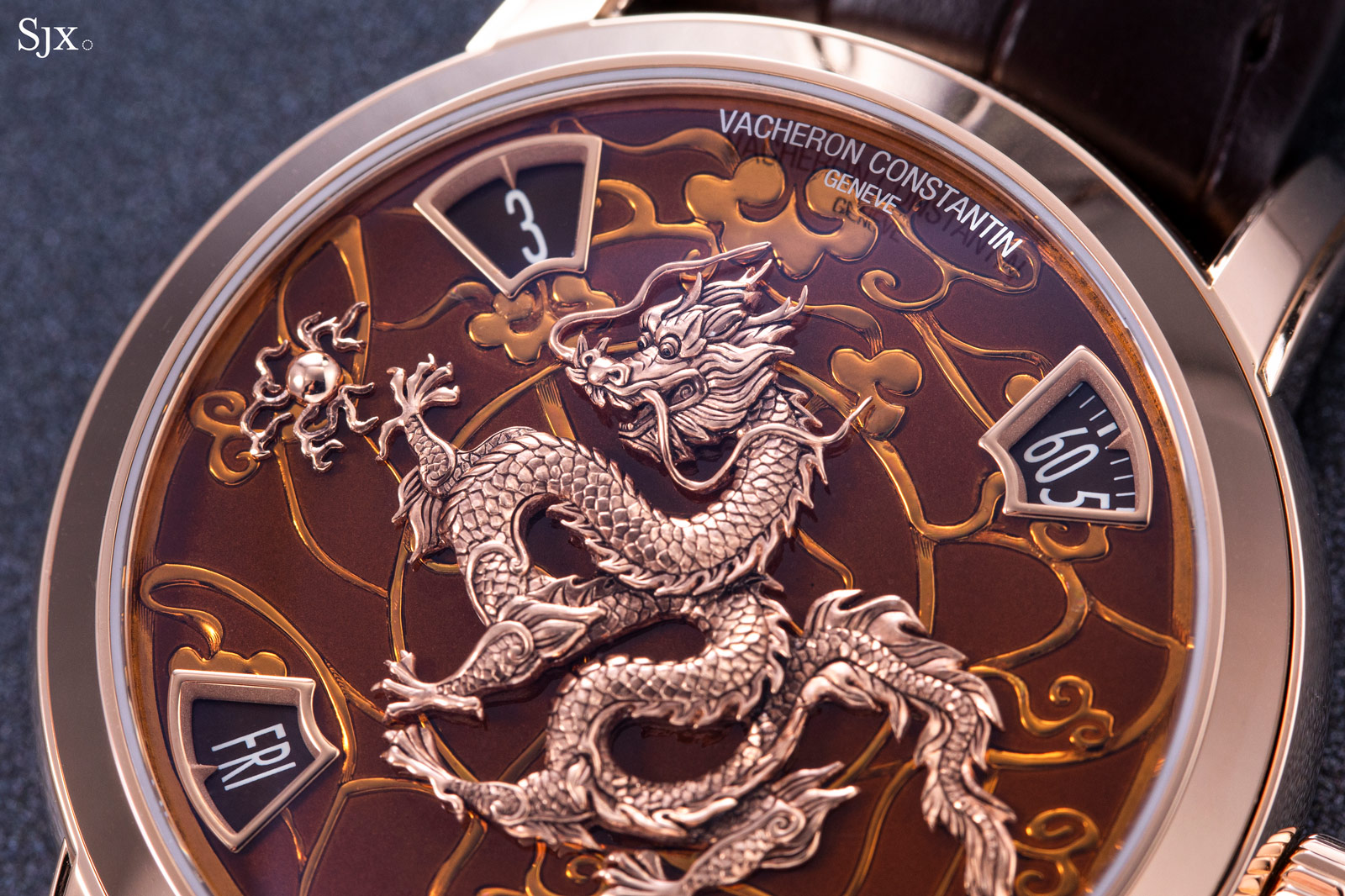
Importantly, the dragon is portrayed correctly. For one, it has five claws, instead of three or four. The five-clawed dragon was once an emblem reserved only for the Emperor of China, and occasionally finds its way into dragon-themed watches. Also, the dragon has the same wide-eyed look that characterises the dragons portrayed on historical artefacts, like the robes of ancient China.
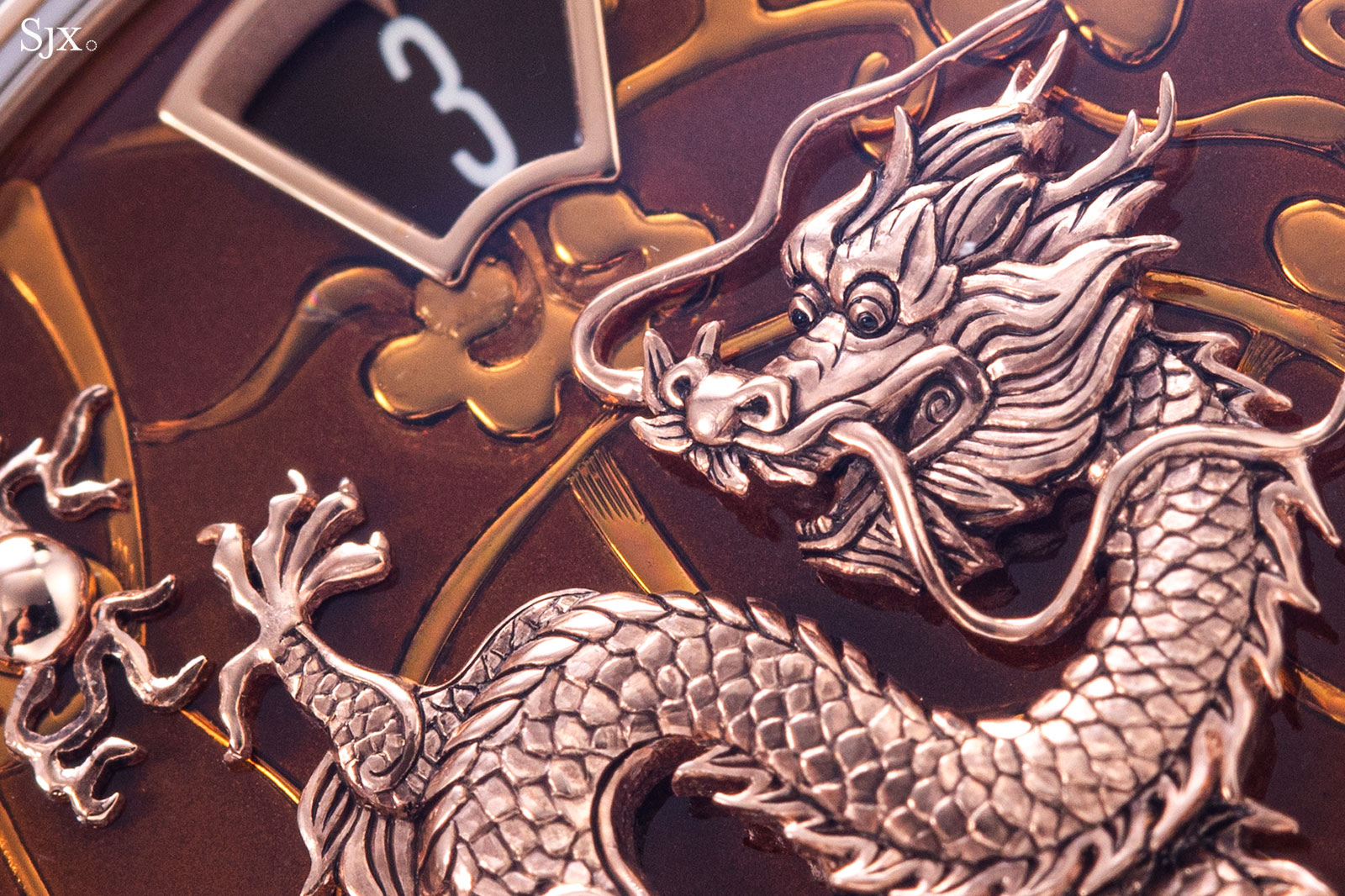
Unsurprisingly, the dragon boasts tremendous detail. The depth of the engraving is particularly evident on its face and claws. Although the dragon is barely a 1 mm high – it fits in between the dial and crystal after all – the sculpture manages to convey a sense of depth thanks to subtle shading along the dragon’s body.
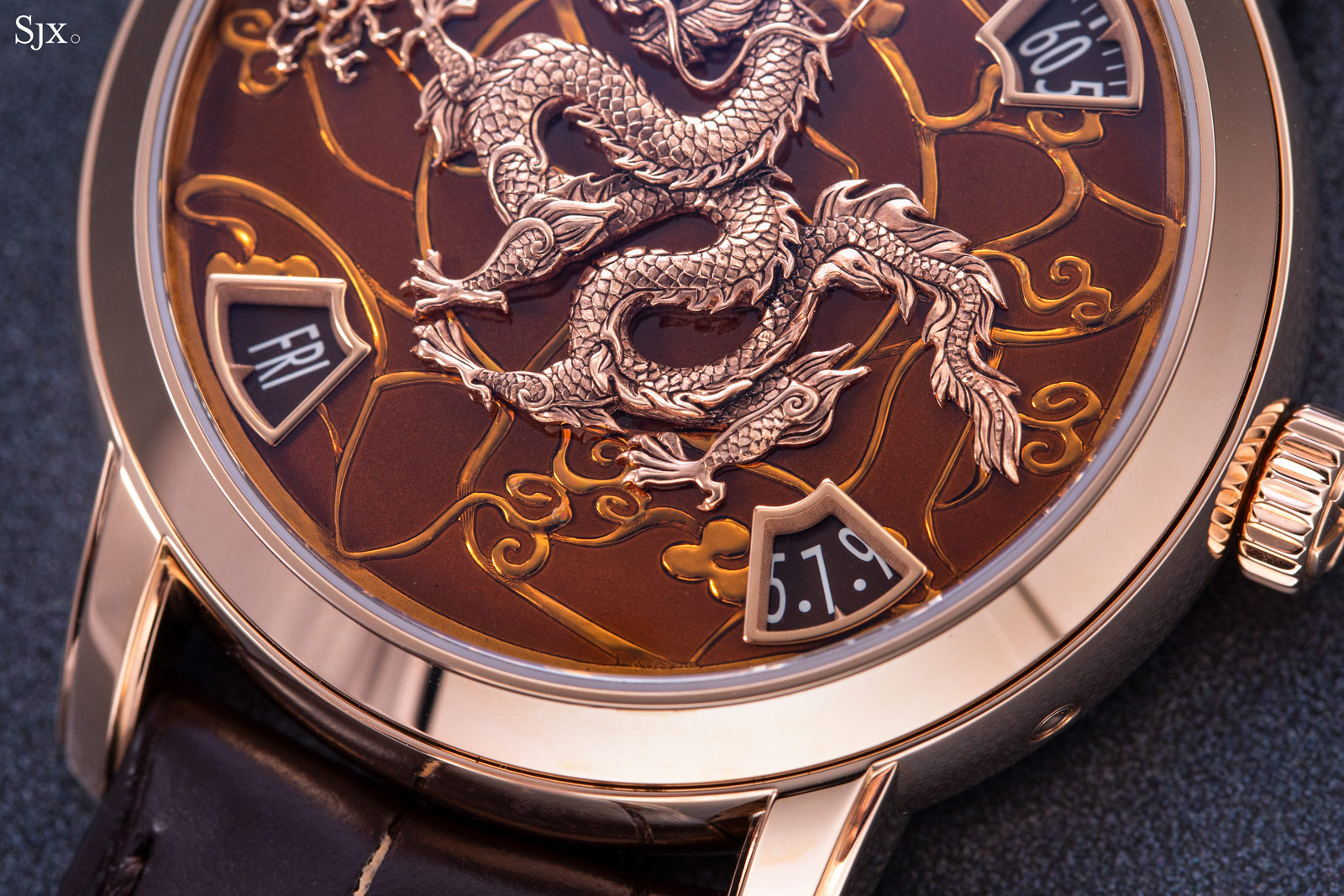
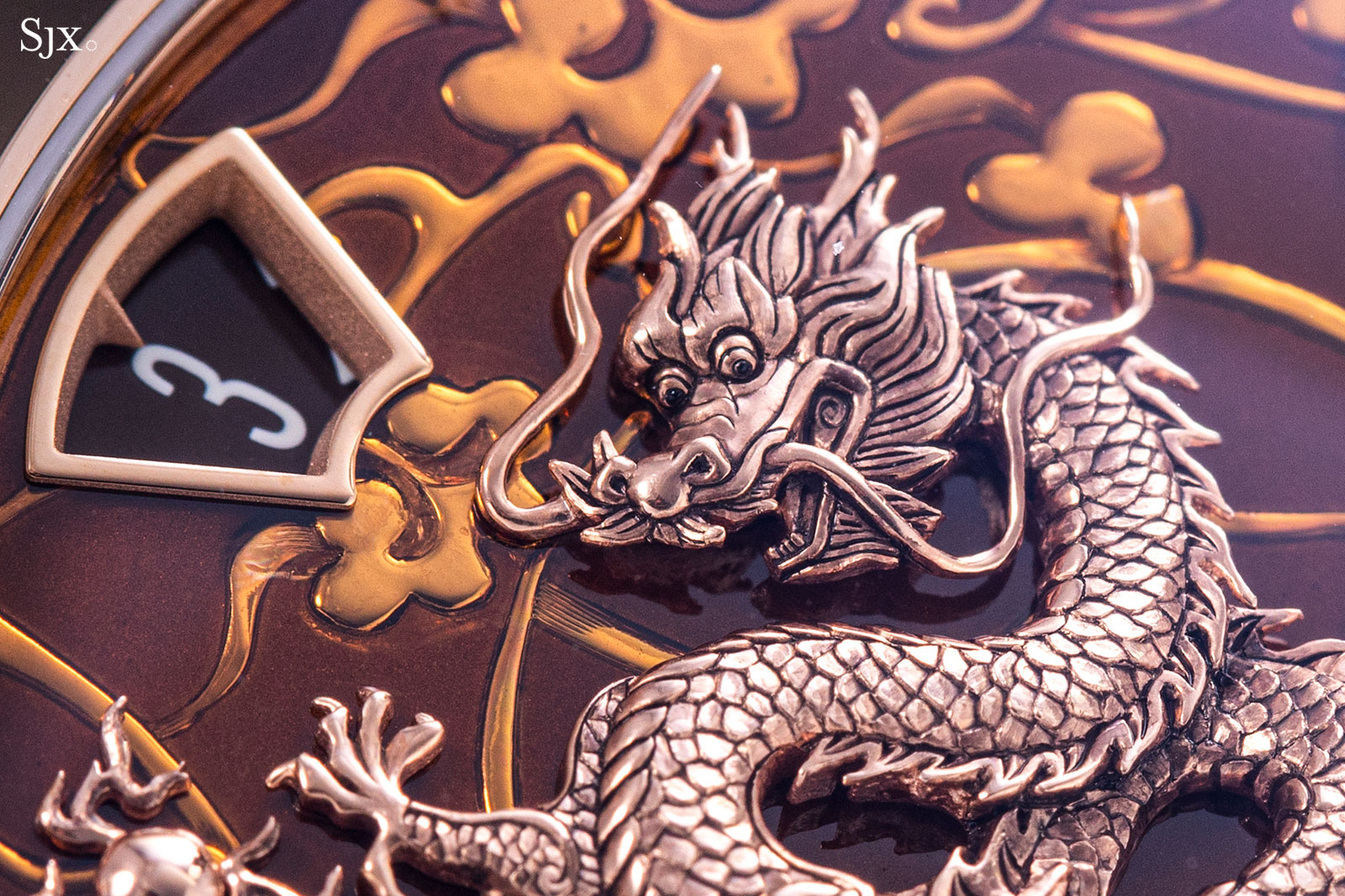
The backdrop for the dragon are stylised clouds that are engraved in relief on the solid gold base, then covered with translucent enamel. Both the engraving and enamelling are high quality; the enamel in particular is vivid in colour with the most minor of imperfections.
However, echoing my comments above, I would have liked the background in another colour. The two versions of the watch match the dragon to the background, while I would have preferred more contrast instead. Such colours would have historical precedence: a pink gold dragon on a yellow enamel background, for instance, would echo the colours of a traditional Chinese dragon robe.
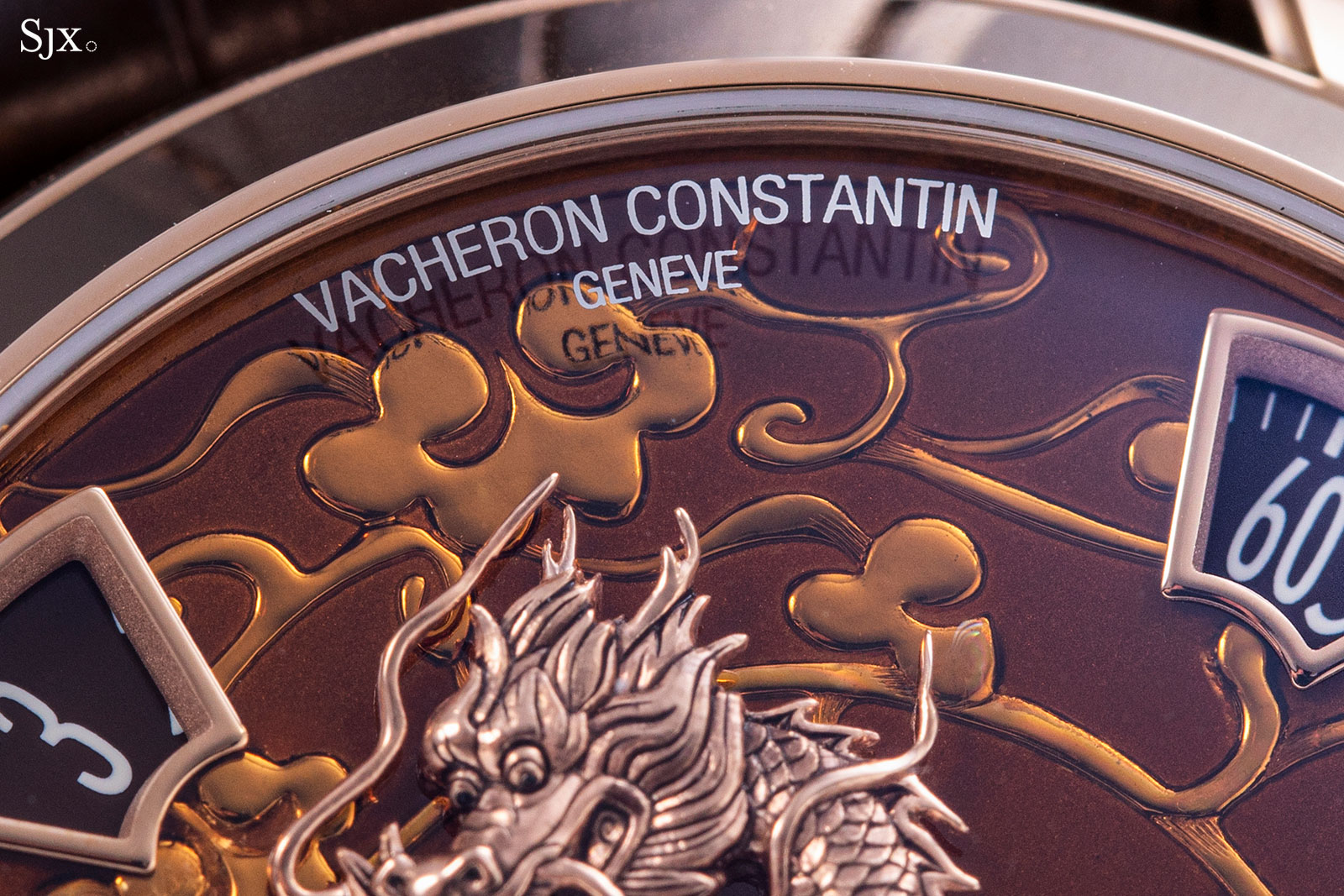
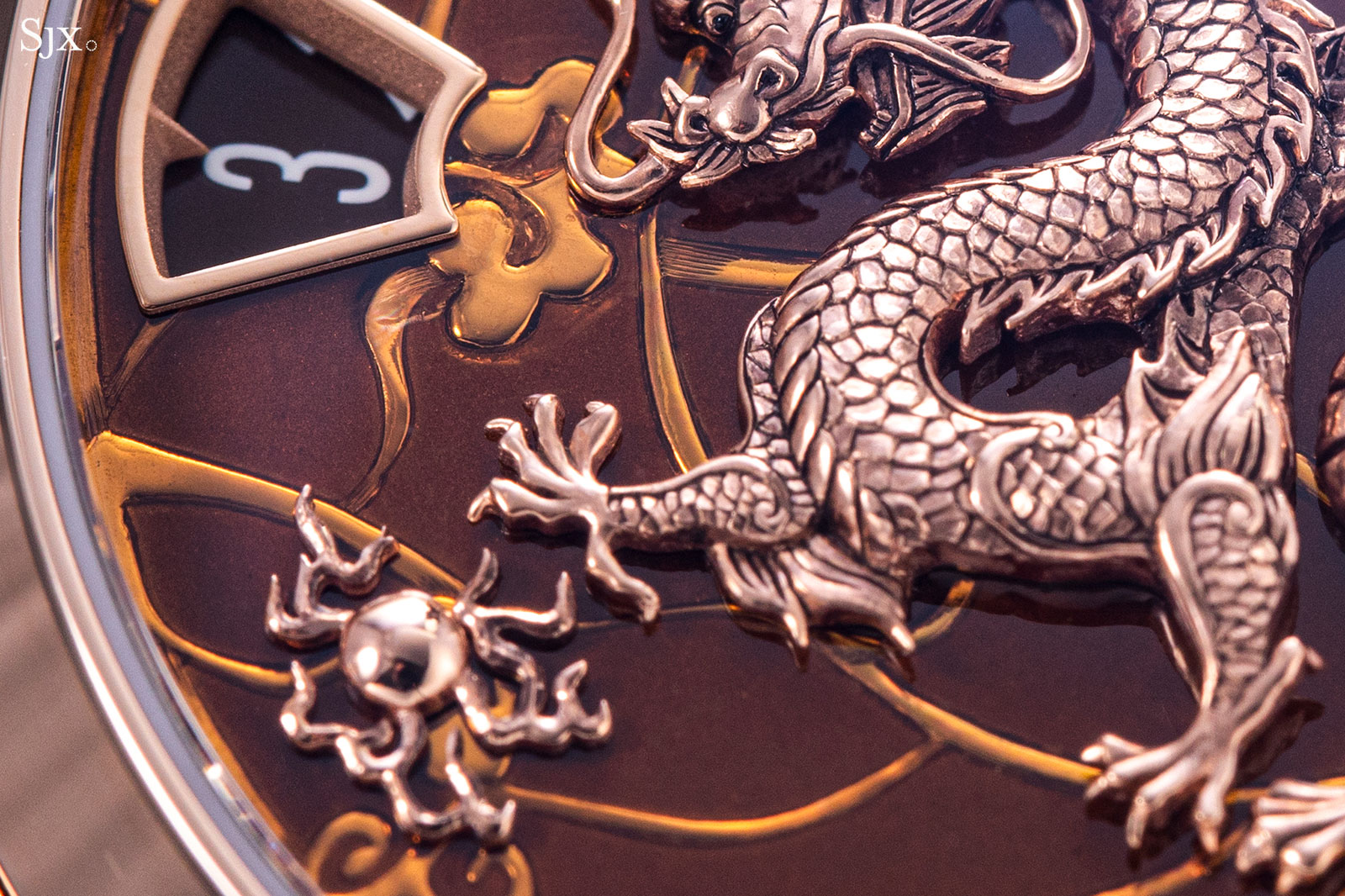
A four-way display
Inside the “Year of the Dragon” is the cal. 2460 G4, which is surprisingly now almost two decades old. The movement was introduced in 2005 for VC’s 250th anniversary. An entirely new calibre at the time, the cal. 2460 (and the related cals. 2450 and 2455 found in the 222) was developed as the brand’s cornerstone automatic movement. It’s now been iterated into variations with assorted compilations, including a retrograde calendar and complete calendar.
But the cal. 2460 G4 is arguably the most unique iteration, being conceived specifically for Métiers d’Art watches. The very first model to feature this was the Métiers d’Art 250th Anniversary, a set of watch watches each sporting a micro-sculpture of Apollo and his chariot on an enamel dial decorated to represent one of the four seasons.
The brand has used the cal. 2460 G4 since then in numerous Métiers d’Art models, including all of the zodiac editions. All the watches powered by the cal. 2460 G4 have an identical dial layout, although the multitude of motifs and decorations applied mean most of them are distinct. Both dragon watches are relatively restrained in terms of colour compared to past models that were positively polychromatic.
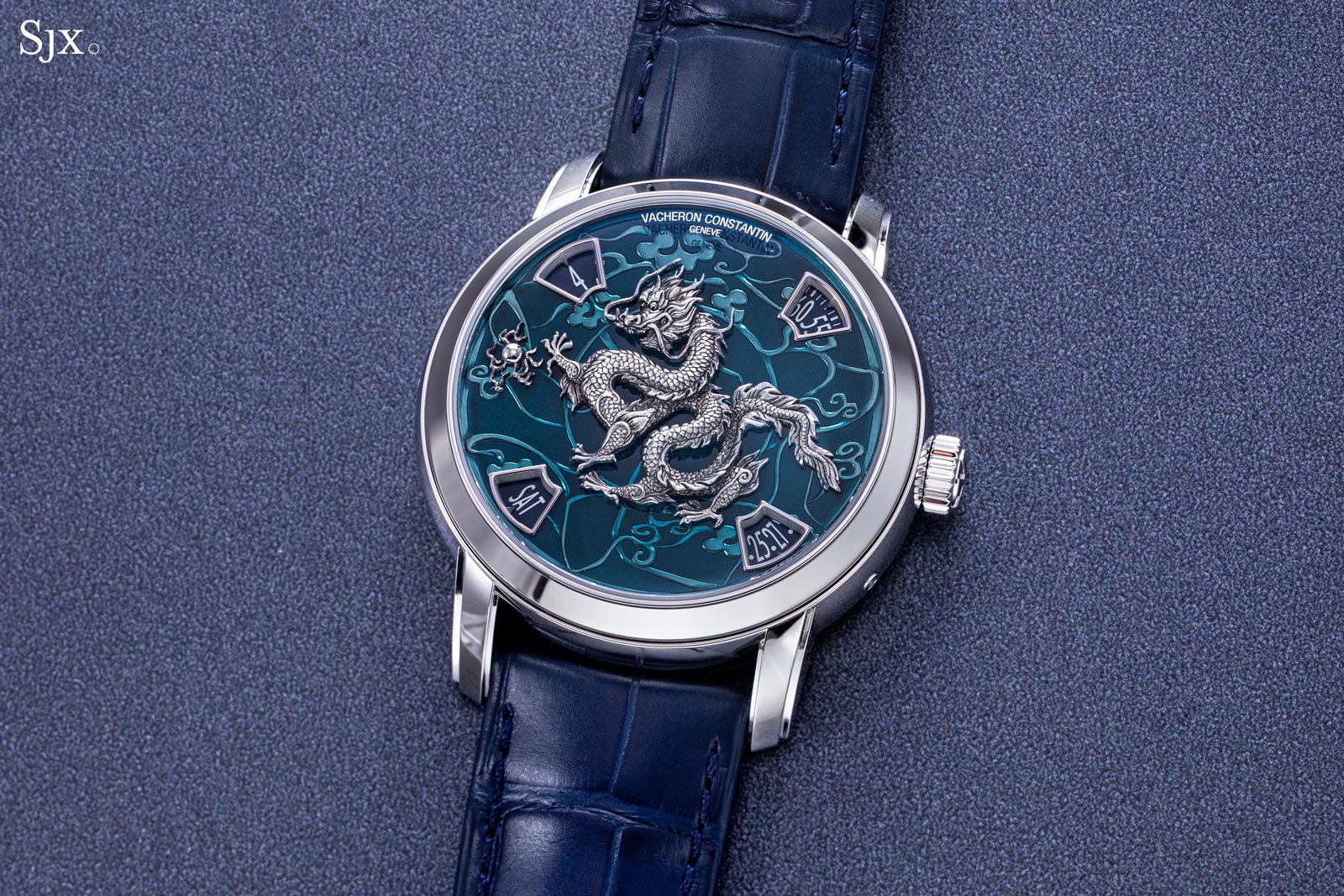
The cal. 2460 G4 shows both the time and calendar in four symmetrically positioned windows that are almost decorative elements in themselves. Each of the windows is fan-shaped and flares outward from the dial, which gives visual emphasis to the sculpture in the centre.
Though novel on its face, the cal. 2460 G4 has a straightforward display. The time is shown in the upper windows and the calendar on the lower windows. All of the indicators are easy to read, although some might find the numerals a bit small; the size of the minute scale means reading the minutes is more approximate than exact.
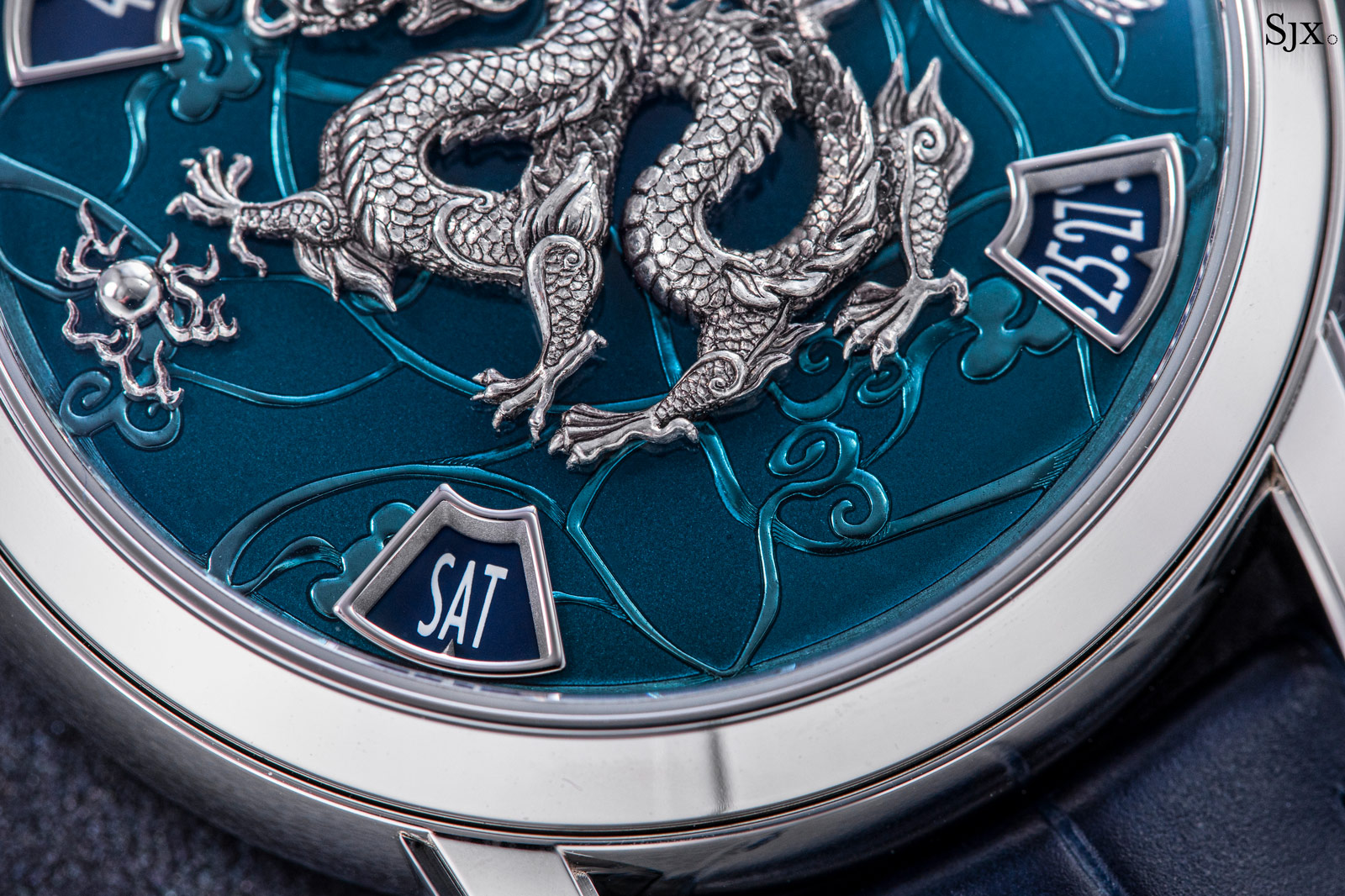
Both the hour and minute discs are of the “dragging” variety, so they rotate continuously throughout the day. In contrast, the day and date indicators below are jumping, so both jump forward one step at midnight like a conventional date mechanism.
The difference between the indicators is simply a matter of technical considerations, namely energy consumption and space. Jumping indicators require more energy, which diverts energy away from the regulator, all things being equal. The Lange Zeitwerk, for instance, has twin jumping digital displays that require so much energy a remontoir is employed to regulate the energy discharge and ensure enough energy is provided to the jumping displays.
Energy consumption can be managed with more space, by using a larger mainspring, inserting a remontoir, and so on. But the cal. 2460 is a relatively slim movement with limited space under the dial. With these constraints in mind, its constructors did an admirable job of inserting the quadruple displays into a relatively small volume of space.
The under-dial view shows that the hour and minute discs are driven by additional gearing extending from the going train, while the calendar discs have their own jumper fingers and tension springs, along with elongated correction levers (that are operated by recessed pushers in the case). The refined construction of the under-dial mechanism brings to mind the retrograde date in the Traditionnelle, an even simpler mechanism but also approached in a sophisticated manner.
Another noteworthy feature of the display module is size. Its diameter is substantially larger than that of the base movement, which was clearly done with the dial layout and proportions in mind. This explains the excellent proportions of the dial, with the windows almost resting on the edge of the bezel, while the cal. 2460 visible behind is noticeably smaller than the 40 mm case.
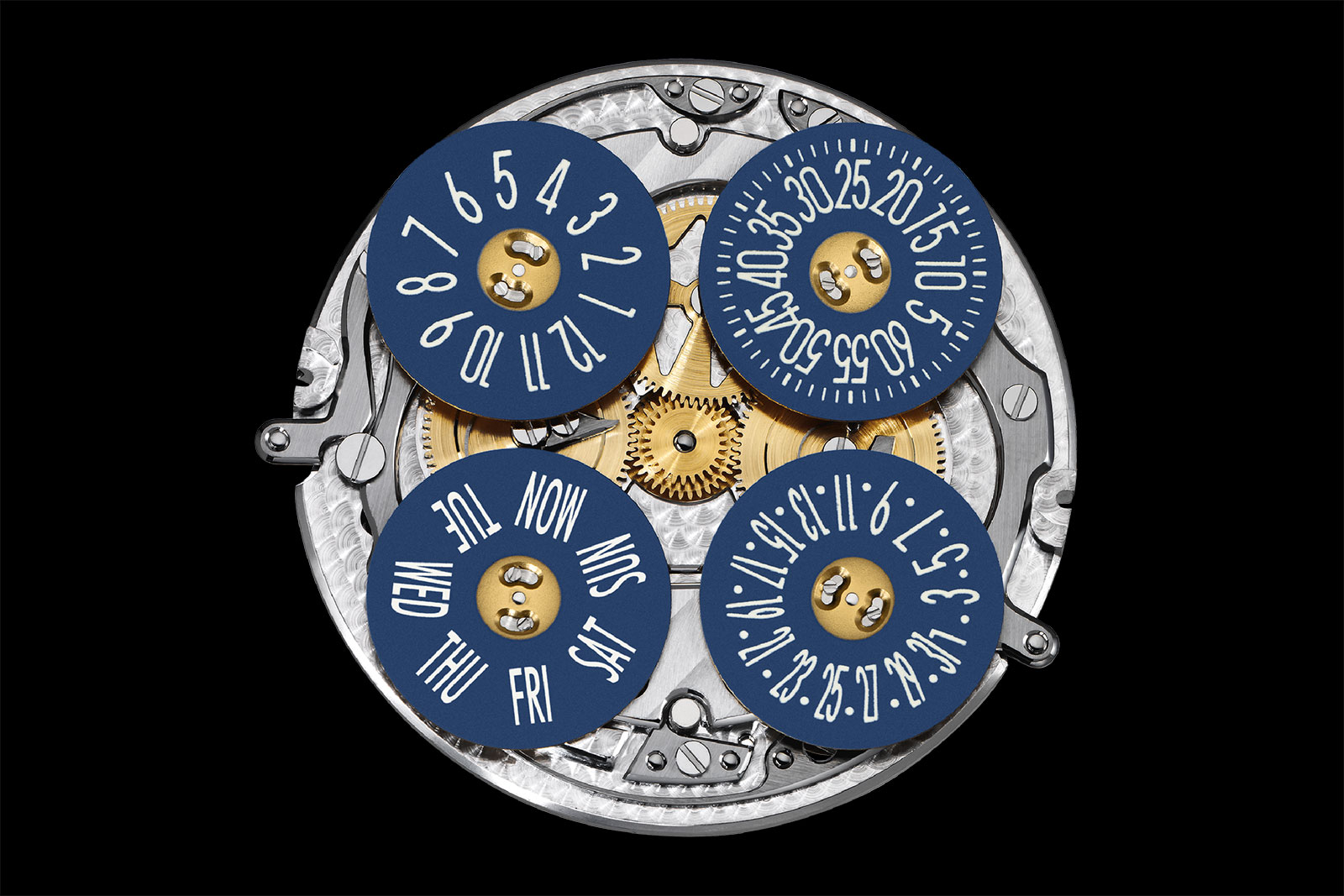
The under-dial view of the cal. 2460 G4. Image – Vacheron Constantin
From the back, the rest of the cal. 2460 is visible. Although now 20 years old, the cal. 2460 and its relatives remain notably sophisticated in terms of construction and details. In other words, it remains an expensively conceived movement, even compared to newer calibres.
Amongst the notable details are the Geneva-style stud holder with a lateral screw for fine regulation – these elements could have been done more simply but they are beautifully executed and faintly vintage-inspired.
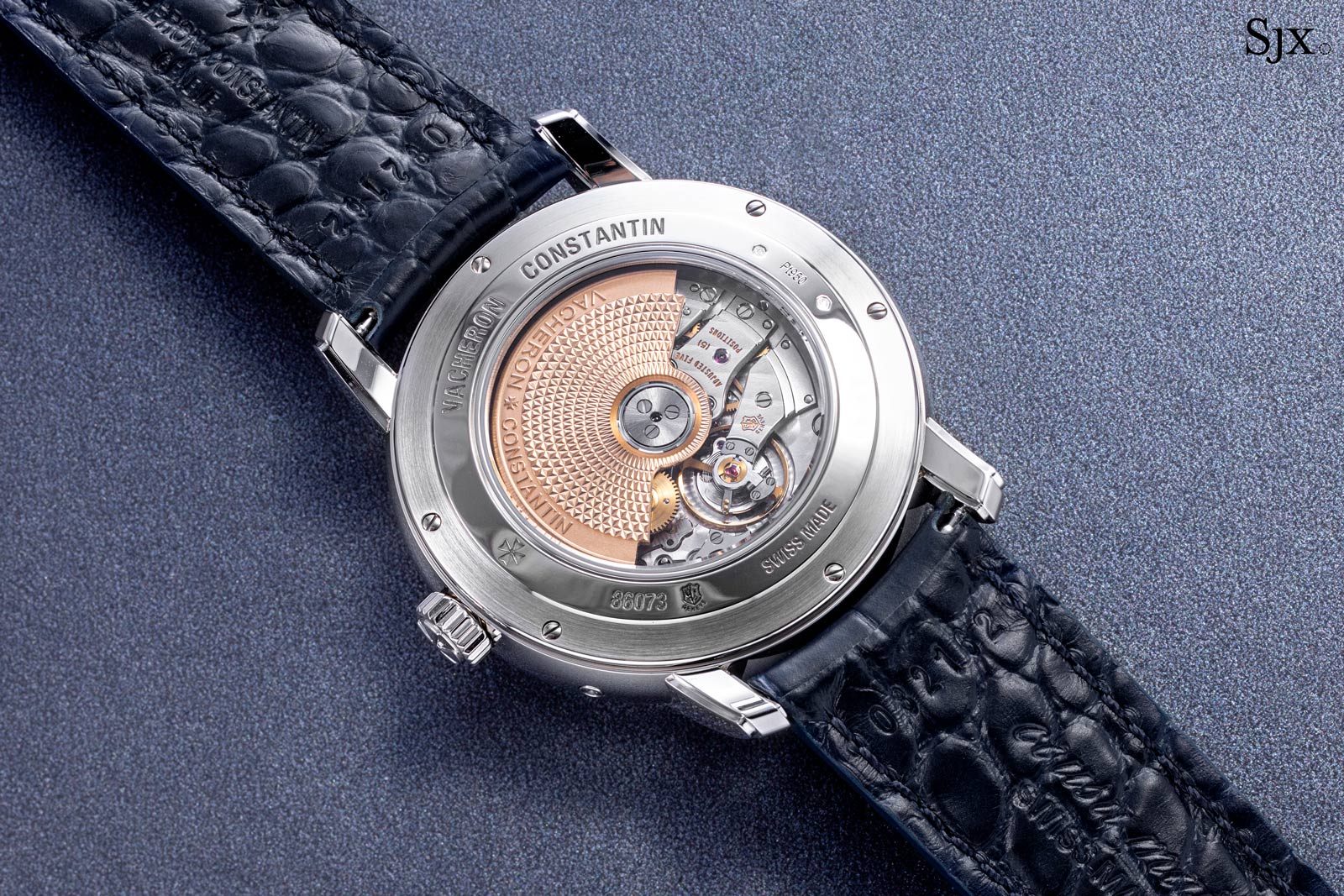
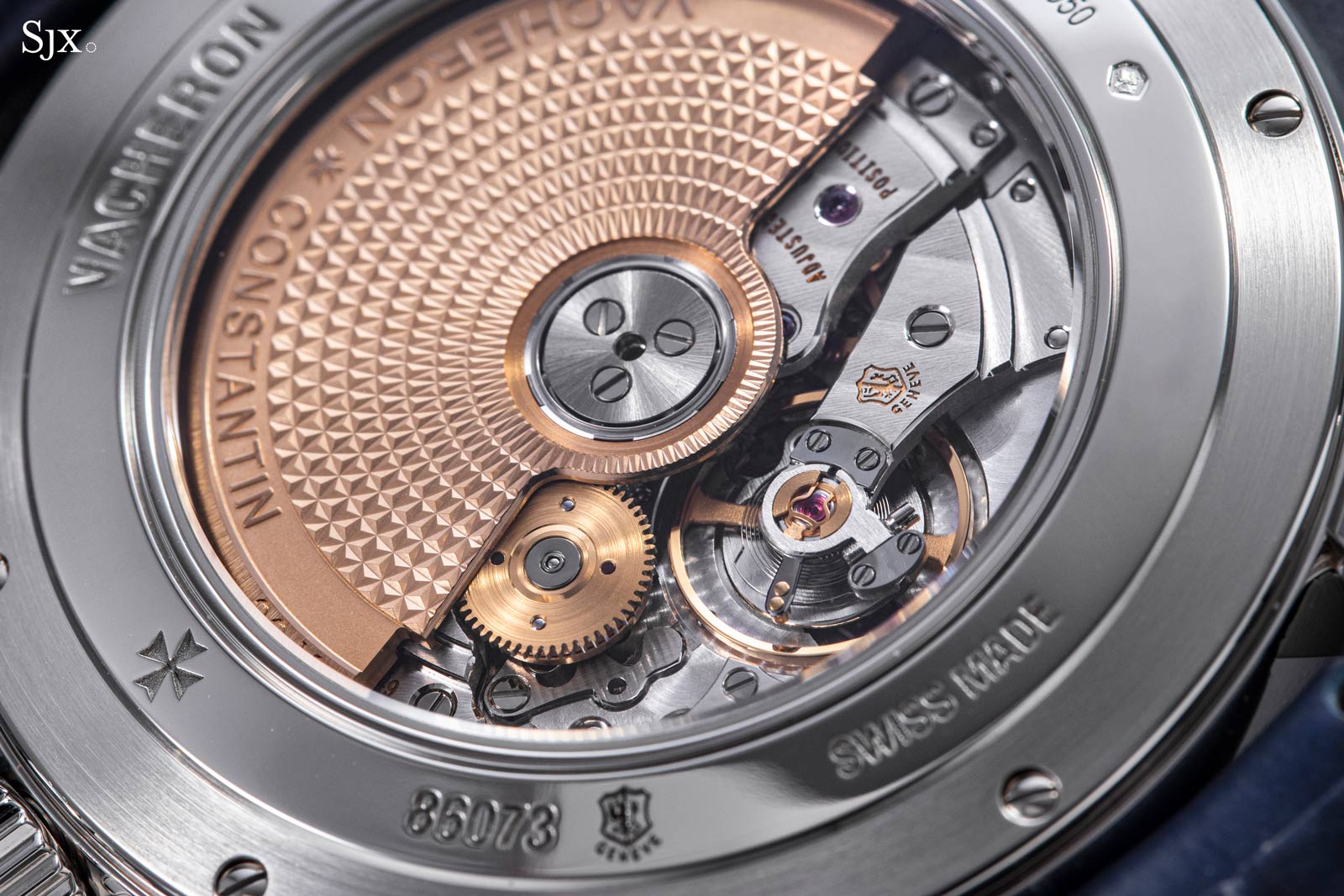
A more modern aspect of the movement but no less notable is the robust and unexpectedly fancy hacking mechanism for the seconds. When the crown is pulled, a series of levers move to extend a narrow finger that touches the rim of the balance, stopping it for more precise time setting. Once again this could be done in a simpler but equally effective manner, but instead the hacking mechanism is thoughtfully designed and deservedly exposed on the back.
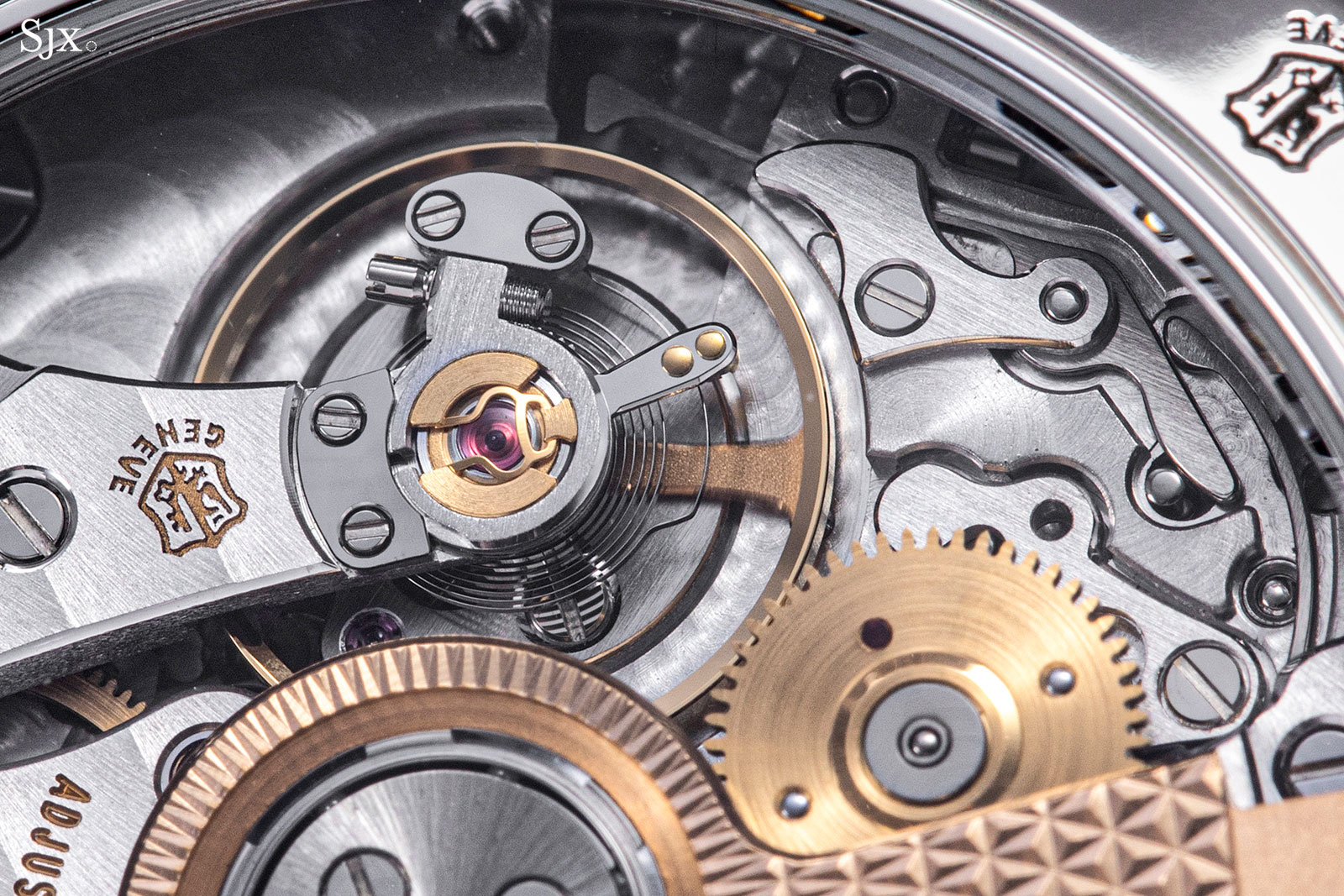
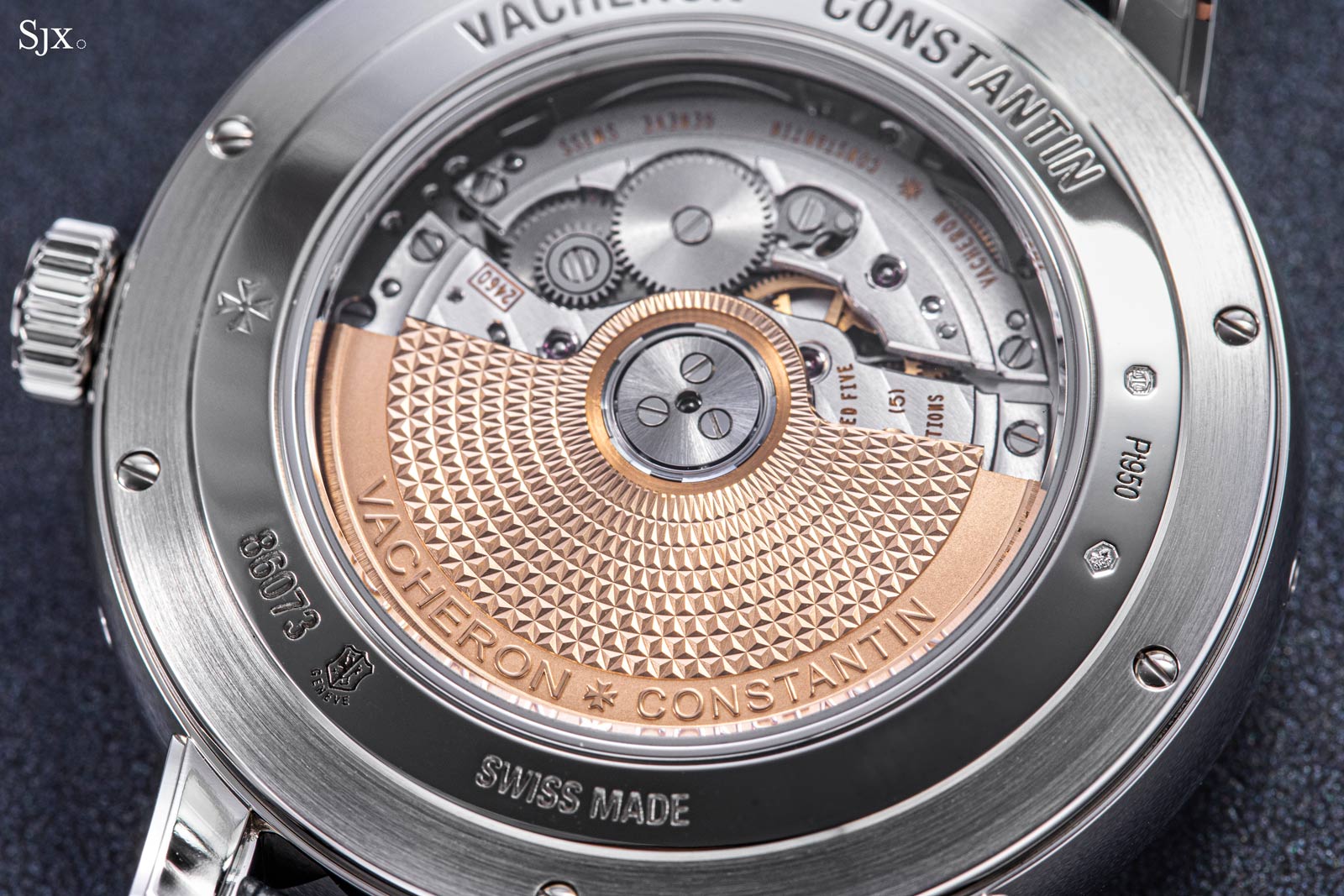
Like the construction, the finishing of the movement is up to scratch. The bridges have wide, rounded bevelling along their outer edges, along with comparably wide counter sinks for jewels and pins. The inner edges of the bridges facing shallow recesses, however, sport narrower milled anglage, an acceptable compromise given the context. This is also a reflection of how to do artisanal-industrial decoration well, something that arguably only a few brands have mastered, including VC’s rivals like Patek Philippe and Audemars Piguet.
In another example, the barrel ratchet wheel is finished with concentric graining in top, and its teeth feature faint bevelling, while the winding click is straight grained and bevelled on its edges – both of these appear to be finished by hand. The two components are secured by screws that are polished and chamfered, as are the rest of the visible screws in the movement.
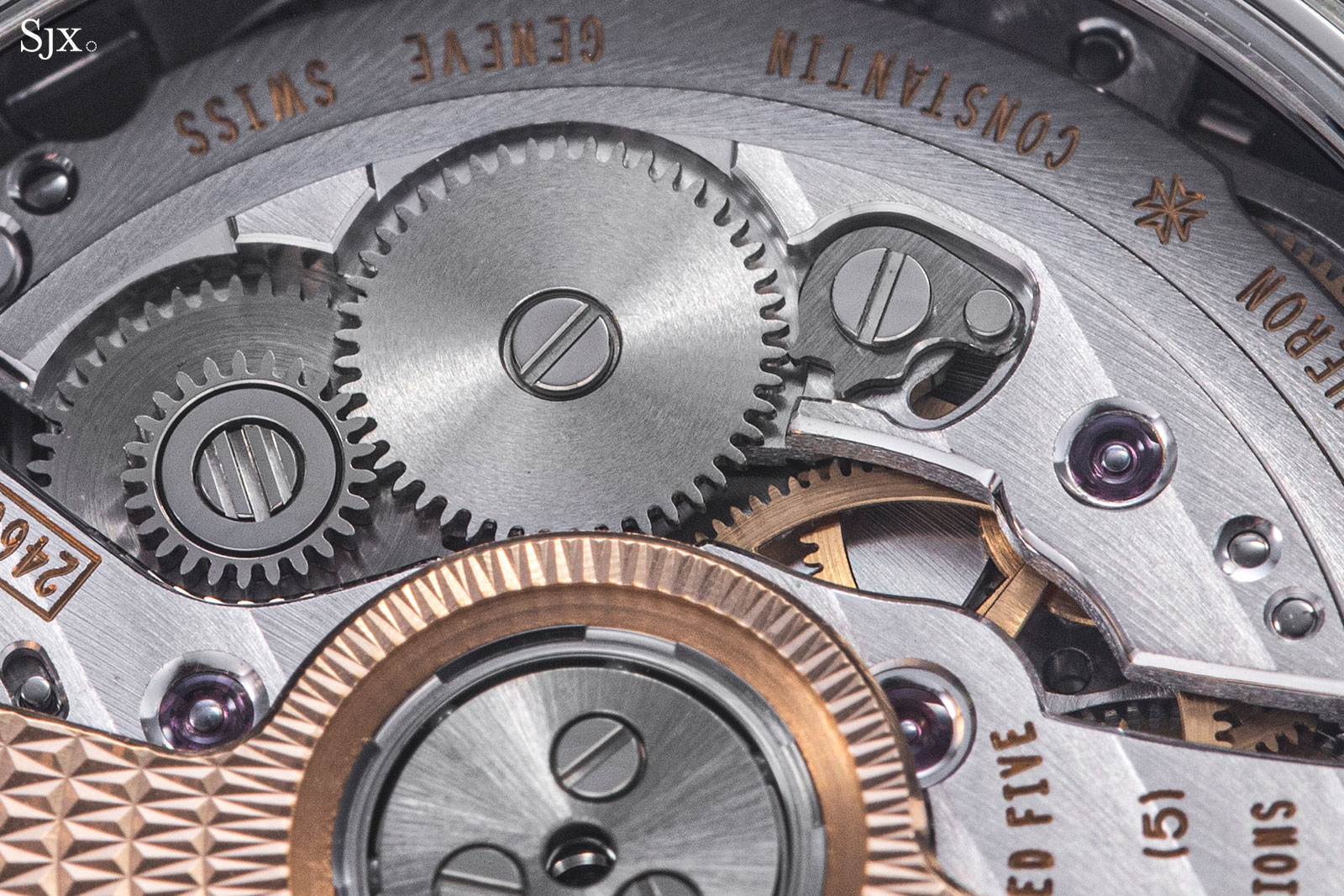
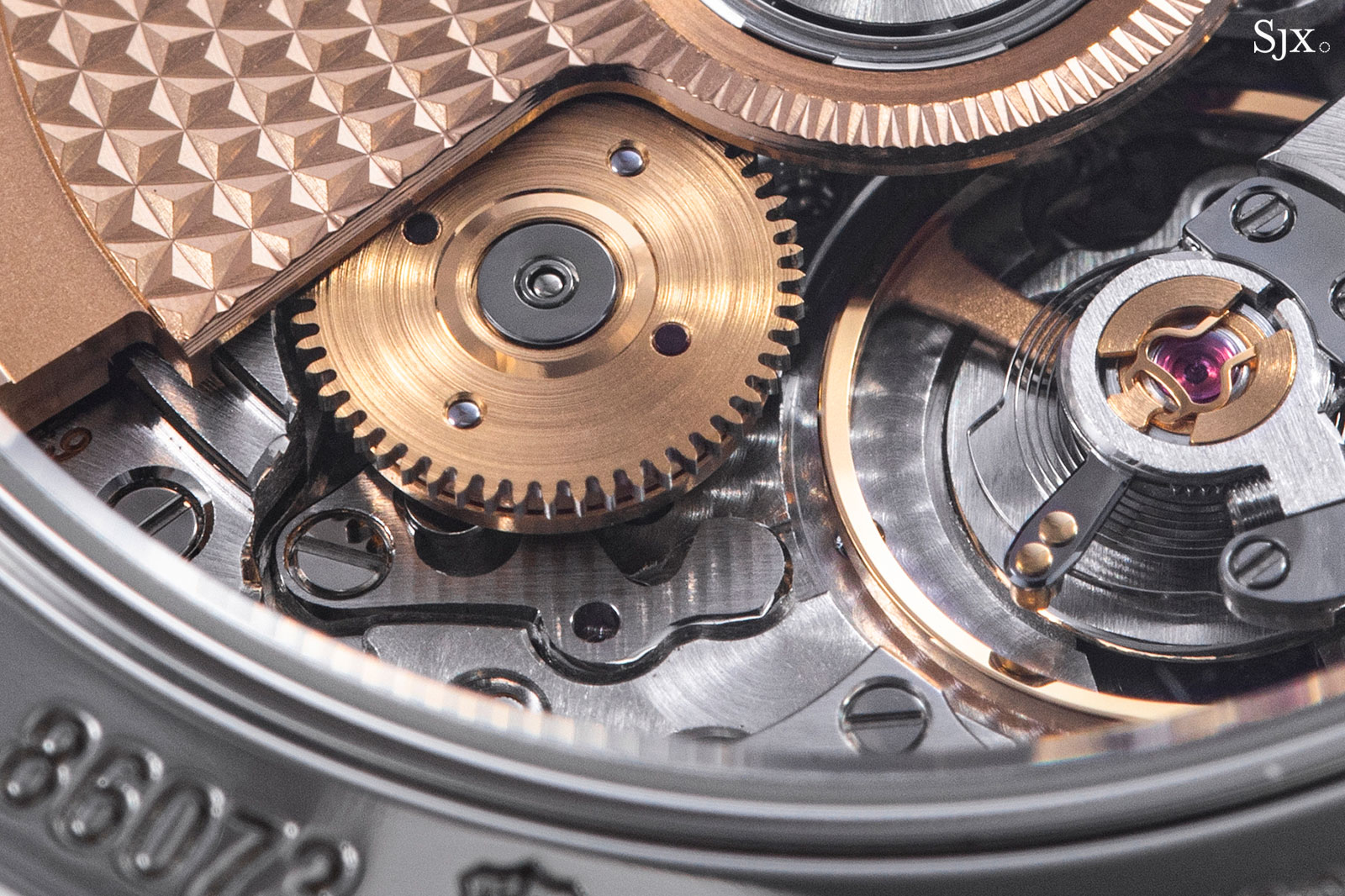
Concluding thoughts
The Métiers d’Art “Year of the Dragon” is executed well in all respects. The enamelling and engraving is high quality, while the movement, despite being relatively simple in function, is constructed as a high-end movement should be.
I do wish the case were a bit thinner, but that is technically impossible with the height of the dial and display. And I do wish the dial was done in another colour, which is probably possible as a Les Cabinotiers project, but likely at a price that isn’t the same reasonable proposition as this limited edition is.
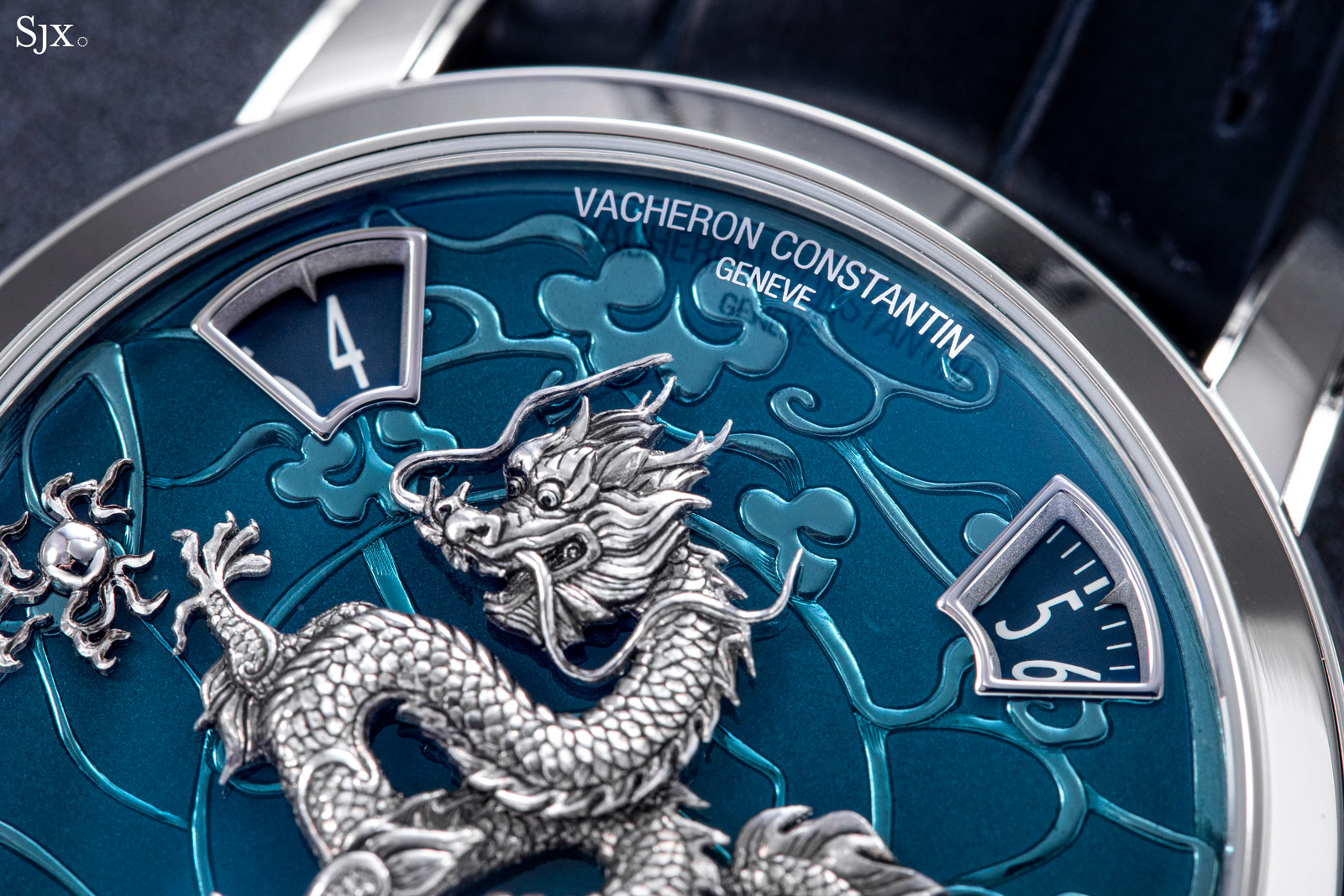
Key facts and price
Vacheron Constantin Métiers d’Art The Legend of the Chinese Zodiac – Year of the Dragon
Ref. 86073/000P-B982 (platinum)
Ref. 86073/000R-B983 (pink gold)
Diameter: 40 mm
Height: 12.72 mm
Material: Platinum or pink gold
Crystal: Sapphire
Water resistance: 30 m
Movement: Cal. 2460 G4
Features: Hours, minutes, day of week, and date
Frequency: 28,800 beats per hour (4 Hz)
Winding: Automatic
Power reserve: 40 hours
Strap: Alligator with folding clasp
Limited edition: 25 pieces in each metal
Availability: At Vacheron Constantin boutiques only
Price: Pink gold is US$112,000, or 174,000 Singapore dollars; price of platinum on request
For more, visit Vacheron-constantin.com.
This was brought to you in partnership with Vacheron Constantin.
Back to top.

